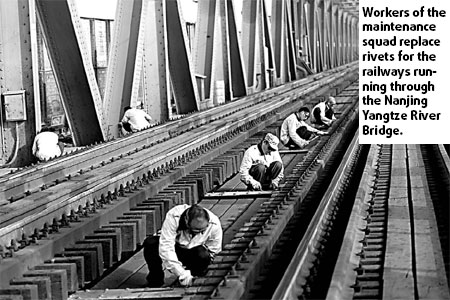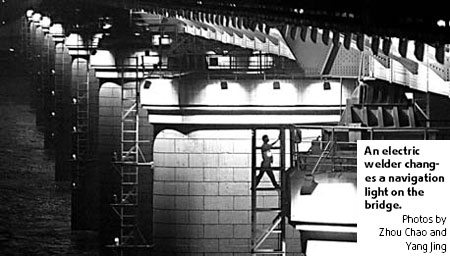The riveting history of a 50-year-old bridge

Early every morning, Xiao Xiaoxue rides to his workshop at the foot of the Wuhan Yangtze River Bridge. He puts on a conspicuous yellow jacket and at 8:30 am leads his team on a routine maintenance examination of the bridge.
Using advanced techniques, Xiao and his colleagues check for cracks on the tracks. They remove rust, tighten screws and replace rivets, or repair crossties by winding iron wire around them. They also clean up the trash dropped by train passengers.
Xiao has been with the maintenance squad since 1971 and is now a deputy foreman. He will retire in just 40 days, but before that he will help out with two more major projects - replacing about 1 million rivets with high-intensity bolts and changing the boardwalk.
Xiao is modest about his work.
"There is really nothing to be proud of. What we do is not heroic. We are just a group of ordinary workers doing a regular job. Our lives are simple and uneventful," he says.
Yet Xiao's job is indispensable to the safe operation of the Wuhan Yangtze River Bridge, which celebrated its 50th anniversary, on October 15 this year.
It was China's first railway-highway bridge over the Yangtze River. Before it spanned the waterway, the river was known as a "natural barrier" between the north and south of China.

Ferries were the only way to cross the river and even trains were transported, carriage by carriage, over the water before the bridge was built.
The completion of the bridge connected the southern and northern railways and, according to Chairman Mao Zedong, "turns a deep chasm into a thoroughfare".
In its latest appraisal, in August, engineers found no cracks or distortions on the bridge's eight piers and steel girders, that weigh 24,805 tons. None of its rivets was loose, either.
The bridge has withstood severe natural and human tests over the past five decades and remains strong, principally because of workers like Xiao.
The inspectors and workers who look after the bridge are affectionately called "nannies", but most people do not appreciate the importance of their work.

The earliest trackmen on the Wuhan Yangtze River Bridge were descendants of its builders. In the late 1970s, squads of veterans joined the profession and it is their offspring who now comprise the bridge's main workforce. The team will sometimes employ rural migrant workers too.
"We shoulder the responsibility of guaranteeing the safety of passengers on trains. We must always take care even with the simplest job," 32-year-old Xiao Zhicheng says.
He started working in the bridge's workshop at the age of 17. Currently he manages railway safety measures.
Every day, about 80 carriage trains cross the bridge's four tracks, four times more than 50 years ago. Every six minutes, an electric train crosses the bridge at high speed.
"Our work often puts us in a position of danger," Xiao Zhicheng says. Though the train station sends out warning signals to the trackmen so they can retreat to safe areas in time, there can be breakdowns in communication. One winter, a trackman didn't hear the alarm of an upcoming train because he was wrapped up against the cold. Luckily the train's breakman pulled up in time.
Though Xiao Xiaoxue and Xiao Zhicheng are deeply attached to the bridge after their decades of service, neither of them wants their children to carry on doing their jobs.
Xiao Xiaoxue's son became a mechanic after he retired from the military. Xiao Zhicheng married last year but hopes his son or daughter gets a higher education and takes up some other profession.
"It is dangerous and laborious work, after all. Most people in this trade are not well educated," Xiao Xiaoxue says.

(China Daily 11/22/2007 page20)














